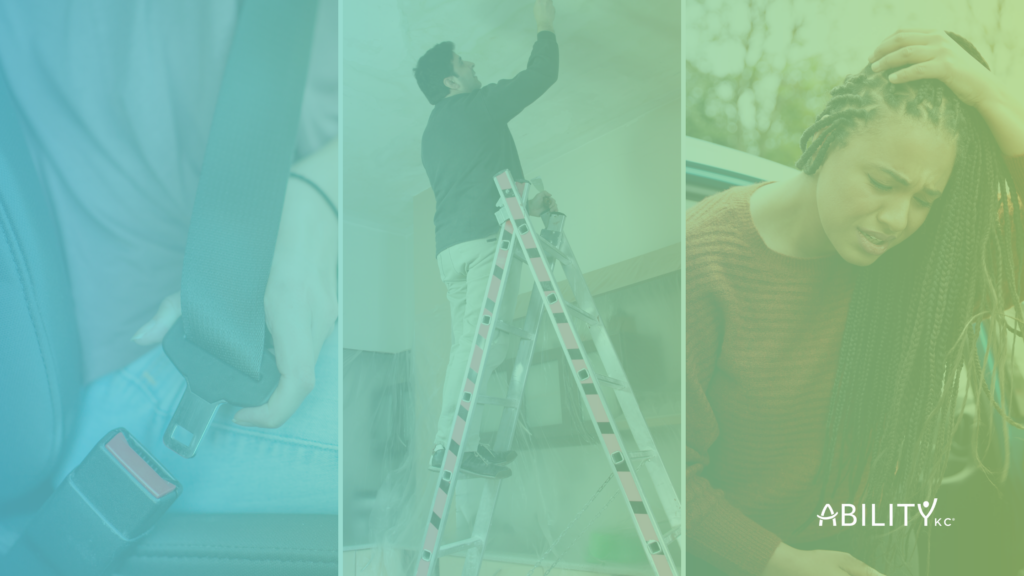
Per the Brain Injury Association – 2.8 million Americans sustain a Traumatic Brain Injury (TBI) each year. However, there are many ways to reduce the chances and long-term impacts of Brain Injury. Below we have listed the most common causes of Brain Injury and prevention tips.
Concussion:
Don’t over think it, just go to the hospital. It could prevent more serious long-term effects. Symptoms that could warrant more medical attention (from Brain Injury Association):
-Persistent headache
-Dizziness or decreased coordination
-Ringing in ears
-Loss of consciousness
-Nausea/vomiting
-Noise or light sensitivity
-Sleep disturbance
-Increased fatigue
-Irritability or increased emotionality
-Forgetfulness
-Poor concentration
-Blurred or double vision
-Slurred speech
Follow precautions from a medical provider if you’ve had a concussion. Gradually return to activities as indicated by your medical provider. Don’t rush to return to activities, it could make symptoms worse.
Motor Vehicle Accidents (MVA)
Buckle up every time you ride in or drive a vehicle.
The CDC estimates that seat belt use reduces the risk of serious injury or death from a motor vehicle crash by 50% (1: CDC, 2011)
Seat belt use is higher in states that have seat belt laws as a primary enforcement law (e.g. a police officer can pull over a car strictly because a passenger is not using a seat belt) (88% compared to 79%).
Advocate for seat belt laws in your state. Neither Missouri nor Kansas have primary seat belt laws.
Wear a helmet.
Per National Highway Traffic Safety Administration, helmets saved 1,859 motorcyclist’s lives in 2016 and could have saved another 802 (2: NHTSA, 2017)
It is estimated that helmets reduce the risk of head injury for motorcyclists by 69%. (3: Liu, et. Al, 2008)
Helmets are designed to take one impact.
Don’t use a cracked or broken helmet or a helmet that has been in a major accident or crash.
Check your helmet each time you use it.
Falls
Children
Children like to explore, climb, run, and be on the constant move. These activities can sometimes lead to accidents that cause brain injury. Simple additions to your home environment can help reduce the risk of bring injury such as:
Install safety gates at the top of stairs
Install window guards
Use mulch, turf or another soft material around playground equipment.
Adults
Slips, spills, and stumbles can happen to anyone and can result in brain injury. Common misconceptions lead many to believe that falls from shorter heights are less dangerous however while often less fatal the injury can be just as significant.
Follow ladder safety procedures (e.g. three points of contact at all times, don’t carry heavy loads while using ladder, don’t extend or adjust ladder while in use, etc. (6: OSHA, 2003)
Falls from ladders account for 32% of falls for construction workers (7: OSHA Oregan, 2022)
Practice fall prevention measures in your workplace.
Wear fall prevention PPE (e.g. harnesses or lanyards) if there is a risk of falling more than 10 feet (8: CCOHS, 2018) Clean spills immediately do not leave spills unattended.
See https://www.osha.gov/fall-protection/evaluation for additional resources.
Older Adults
In the US, 28% of adults ages 65 and older report a fall each year (9: Moreland, Kakara, Henry, 2020). Some conditions that can make you more likely to fall (10: CDC, 2022):
Lower body weakness
Vitamin D deficiency (that is, not enough vitamin D in your system)
Difficulties with walking and balance
Use of medicines, such as tranquilizers, sedatives, or antidepressants. Even some over-the-counter medicines can affect balance and how steady you are on your feet.
Vision problems
Foot pain or poor footwear
Home hazards or dangers such as broken or uneven steps, and throw rugs or clutter that can be tripped over
Assault
Account for 10% of TBIs (11: Fau, Xu, Wald, Coronado, 2010)
The majority of reported injuries sustained by women experiencing intimate partner violence are to the head or neck (12: Wu, Huff, Bhandari, 2010)
Hypoxic and ischemic brain injury are also commonly associated with strangulation in such cases.
Service providers should ask if individuals we serve who sustained TBI feel safe at home. It will likely to time to build trust and an individual may not disclose abuse immediately.
Service providers should be aware of local domestic violence services.
Domestic violence service providers should be aware of symptoms of TBI and how to screen for TBI.
Various forms such as the HELPPS screening tool are available to guide the screening for TBI.
Domestic violence service providers should conduct universal screenings for TBI.
See https://biapa.org/wp-content/uploads/2021/02/TBI-and-Domestic-Violence-Using-the-HELPPS-Screening-Tool-to-Support-Survivors-BIAPA1.pdf for additional resources for domestic violence service providers. Page Break
Posted by:
Collin Shelton M.S., CCC-SLP
Ability KC Speech-Language Pathologist
References:
1: https://www.cdc.gov/vitalsigns/seatbeltuse/index.html
2: National Highway Traffic Safety Administration. Motorcycles (Traffic Safety Facts Research Note. Report No. DOT HS 812 492). U.S. Department of Transportation, Washington, DC; 2017. Available at https://crashstats.nhtsa.dot.gov/Api/Public/ViewPublication/812492external icon
2: Liu BC, Ivers R, Norton R, et. al. Helmets for preventing injury in motorcycle riders. Cochrane Database Systematic Reviews. 2008
3: https://www.cdc.gov/traumaticbraininjury/prevention.html
4: https://www.cdc.gov/falls/facts.html, accessed 2/15/2022
5: https://www.cdc.gov/headsup/pdfs/helmets/HeadsUp_HelmetFactSheet_Bike_508.pdf
6: https://www.osha.gov/sites/default/files/publications/osha3124.pdf
7: https://osha.oregon.gov/Pages/topics/fall-protection.aspx
8: https://www.ccohs.ca/oshanswers/prevention/ppe/belts.html
9: B, Kakara R, Henry A. Trends in Nonfatal Falls and Fall-Related Injuries Among Adults Aged ≥65 Years — United States, 2012–2018. MMWR Morb Mortal Wkly Rep 2020;69:875–881. DOI: http://dx.doi.org/10.15585/mmwr.mm6927a5external icon
10: https://www.cdc.gov/falls/facts.html
11: Faul M, Xu L, Wald MM, Coronado VG. Traumatic Brain Injury in the United States: Emergency Department Visits, Hospitalizations and Deaths 2002 – 2006. Atlanta (GA): Centers for Disease Control and Prevention, National Center for Injury Prevention and Control; 2010.
12: Wu, V., H. Huff, and M. Bhandari, Pattern of physical injury associated with intimate partner violence in women presenting to the emergency department: a systematic review and meta-analysis. Trauma Violence Abuse, 2010. 11(2): p. 71-82.